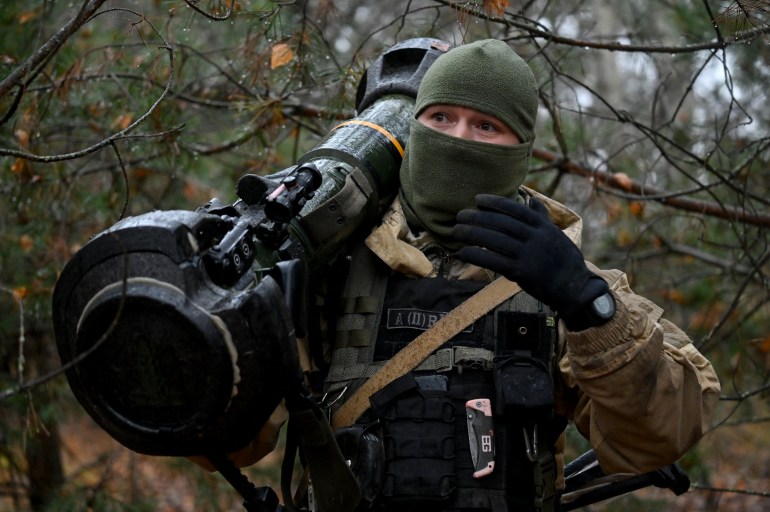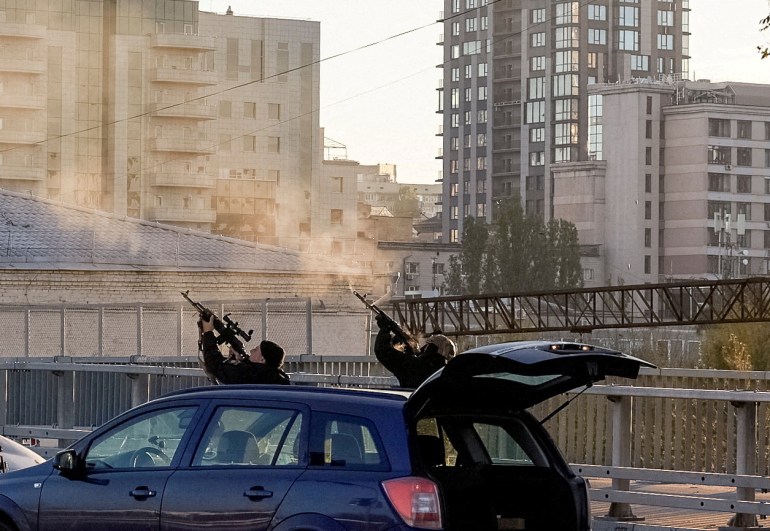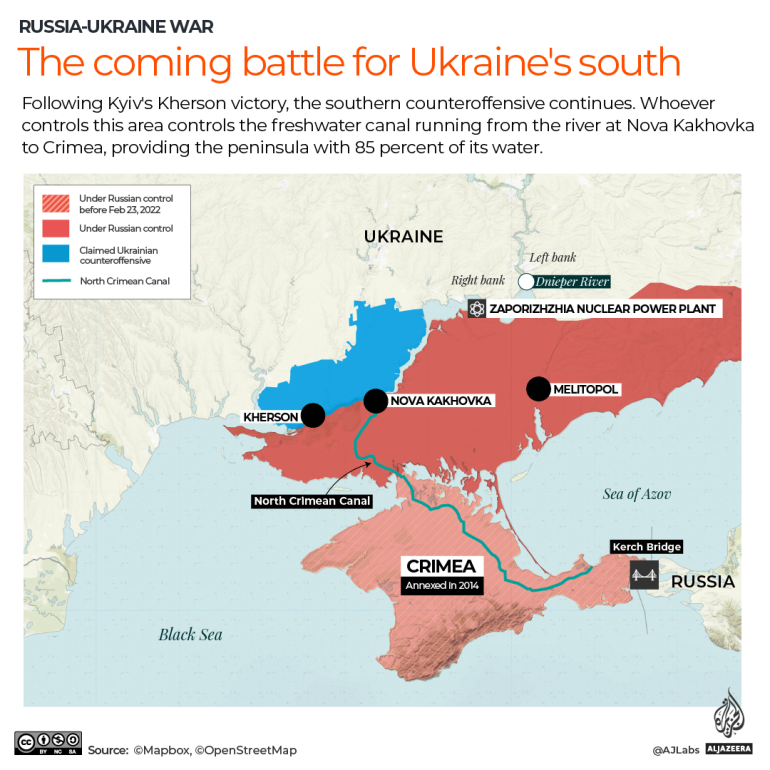What are Russia and Ukraine’s military options for this winter?
As temperatures slowly sink, the nature of the fighting will change sharply for both sides.

There has been a pause in fighting as Russia and Ukraine take stock of their options in the coming winter.
Ukraine, flush from its victory in retaking the strategically vital southern port city of Kherson, has had to pause as troops are rested and re-equipped.
Keep reading
list of 3 itemsRussia under fire over Ukraine missile attacks, Poland deaths
World leaders arrive for APEC under shadow of Ukraine war
Kyiv’s options are currently limited for combat operations as the Dnieper River forms a natural barrier that will need significant effort and planning if it is able to seize and hold a bridgehead while troops and vehicles are brought over in the kinds of numbers needed for offensive operations against Russian units, which are dug in near the river.
The recapture of Kherson was an undoubted political victory for Ukraine, but what comes next could be even more important in deciding the overall war.
Al Jazeera’s @AlexGatopoulos explains ⤵️ pic.twitter.com/nJWpLaZOoX
— Al Jazeera English (@AJEnglish) November 14, 2022
Russia has leveraged its experienced Wagner mercenaries in the northeast and fighting has intensified, centred around the town of Bakhmut.
Ukrainian troops have been sent to this sector to bolster the defences to stop Russia’s slow advance.
Subzero warfare
As temperatures slowly sink, the nature of the fighting will change sharply.
Both militaries are trained to fight in the cold, indeed Russia invaded, and Ukraine fought back, during one the coldest months in 2022 – February – but Kyiv has received far better winter clothing and equipment from NATO militaries.
On the day of the invasion in Kyiv, the temperature was about 3 degrees Celsius (37.4 degrees Fahrenheit). Today, it is 1C (33.8F).
The changes to fighting in subzero temperatures are significant.
With fewer daylight hours, whichever army is more skilled at night fighting will have the advantage. Night vision goggles and thermal imagers have been at the top of the list of equipment requested by Ukraine from the West.
The chances of survival in the “golden hour” – the critical 60 minutes after a battlefield wound – increase if soldiers are treated or moved to a first aid station, and plummet if they are exposed to harsh weather.
In the cold, equipment is more likely to malfunction.
Weapons jam as the frigid temperatures freeze vital parts. Tanks fare better once the ground hardens, but defensive positions are much harder to dig as the ground freezes solid, making artillery barrages all the more deadly.
And it is of course not just the military that will have to contend with changing conditions, the civilian population of Ukraine has been marked by Russia for collective suffering as leverage.

The cold is a weapon
While the world this week focused on what appeared to have been a malfunctioning rocket straying into Poland and killing two people, 10 million Ukrainians were left without power as dozens of Russian missiles struck nodes in the power grid, destroying installations that will be hard to replace.
This is a situation that will only get worse if these attacks continue. It now looks like this is Putin’s strategy Russia holds territory, aiming for small gains while pounding power stations, supply lines, fuel depots and storage facilities to bring Ukraine to its knees and thus to the negotiating table.
The situation is so extreme that the Ukrainian government is reportedly now considering evacuating the capital, Kyiv, to preserve lives, as heating the city is no longer guaranteed.
Energy does not heat only homes – without it, factories cannot run, petrol cannot be pumped, and street lights cannot shine.
Ukraine’s infrastructure would be crippled, and civic life would start to grind to a halt.
Almost 40 percent of Ukraine’s power grid has been destroyed or damaged, and it will take months to fix as spare equipment remains in short supply.
Iran again
While Russia may have identified this as an effective strategy, troops will need large inventories of cheap cruise and ballistic missiles, weapons the military is increasingly short of.
They will have to depend on imports as the Russian defence industry struggles to produce them in the quantities needed.
Russia’s reliance on Iran is only set to grow as it becomes the main supplier of cheap, effective weapons.
Weapons like the Shahed-136 loitering munition and the Mohajer-6 combat drone have been used effectively, especially when launched in swarms.
Still, Ukrainian air defences have managed to shoot down the vast majority.

Not seen yet on the Ukrainian battlefield but worthy of consideration are the arsenals of cheap, reasonably accurate ballistic missiles that Iran has to offer.
Weapons like the Fateh 110 and the Zolfaghar ballistic missiles have ranges of up to 700km (435 miles) and are accurate enough to destroy point targets like supply dumps, radar installations, or power stations far behind the front lines.
If Ukraine is to shoot down all these Russian missiles and drones, it will need an equal number or greater air defence missiles.
Ukraine has done an impressive job integrating a wide variety of missile and radar systems into its existing air defence network, but the war-torn nation needs to be supplied quickly to fend off Russian attacks this winter.
The coming battle for the south
Ukraine is not just relying passively on its air defences to win this war, offensive combat operations have been highly successful since they began in early September.
In a matter of months, Kyiv’s forces have recaptured at least half the territory they lost since the start of the invasion.
At some stage, Ukraine will need to cross the Dnieper River to destroy Russian defensive positions there.

This area, from the banks of the Dnieper all the way to Melitopol, is the linchpin for this conflict.
Whoever controls it, controls the freshwater canal running from the river at Nova Kakhovka to Crimea, providing the peninsula with 85 percent of its water – this has been a strategic Russian war aim since Ukraine blocked the North Crimean Canal in 2014 when Russia illegally annexed the peninsula.
A successful Ukrainian advance eastwards would slice the neck of Crimea, isolating it from the rest of the country.
It would also make Russia’s occupation of the Zaporizhzhia Nuclear Power Plant untenable as the military would face increasing danger of being cut off and surrounded.
Russian troops there, already at the end of a long rickety supply chain, will have further trouble defending as Ukrainian Himars batteries, having moved east, would be able to destroy supply depots and the rail junctions needed by Moscow’s military logistics units.
An assault over the river would not be easy.
Ukraine will have to attack the far bank of the Dnieper at several points, and maintain beachheads under fire while transporting enough soldiers, vehicles, supplies and equipment to start – and keep up – offensive operations.
Russia cannot defend the whole river bank and Ukraine has shown more skill and sophistication in combined arms operations to launch a riverine assault, combined with helicopter landings and long-range fire.
The grand prize would be Melitopol.
Known as “the gateway to the Crimea”, it is an important transport, rail and logistics hub.
The recapture of this city by Ukrainian forces, along with the blocking of the freshwater canal, would start to make Russia’s military presence in Crimea increasingly precarious and would herald the utter defeat of Moscow’s troops.
Can Russia stave off defeat with imported missiles and large numbers of new conscripts thrown into the front lines?
Josef Stalin is rumoured to have said, “Quantity has a quality all of its own.”
Whether it is enough to stop Russia from losing this war is growing increasingly unlikely.